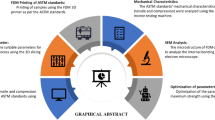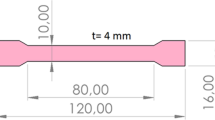Abstract
Recently, low-cost desktop three-dimensional (3D) printers, employing the fused deposition modeling (FDM) technique, have gained widespread popularity. However, most users cannot test the strength of printed parts, and little information is available about the mechanical properties of printed high-impact polystyrene (HIPS) parts using desktop 3D printers. In this study, the user-adjustable parameters of desktop 3D printers, such as crisscross raster orientation, layer thickness, and infill density, were tested. The experimental plans were designed using the Box-Behnken method, and tensile, 3-point bending, and compression tests were carried out to determine the mechanical responses of the printed HIPS. The prediction models of the process parameters were regressed to produce the optimal combination of process parameters. The experimental results showcase that the crisscross raster orientation has significant effects on the flexural and compression strengths, but not on the tensile strength. With an increase in the layer thickness, the tensile, flexural, and compression strengths first decreased and then increased, reaching their minimum values at approximately 0.16 mm layer thickness. In addition, they all increased with an increase of infill density. It was demonstrated that when the raster orientation, layer thickness, and infill density were 13.08°/–76.92°, 0.09 mm, and 80%, respectively, the comprehensive mechanical properties of the printed HIPS were optimal. Our results can help end-users of desktop 3D printers understand the effects of process parameters on the mechanical properties, and offer practical suggestions for setting proper printing parameters for fabricating HIPS parts.














Similar content being viewed by others
References
Yadav DK, Rajeev S, Dev S (2020) Design and fabrication of ABS part by FDM for automobile application. Mater Today: Proc 26:2089–2093
Daneshmand S, Nadooshan AA, Aghanajafi C (2008) Evaluation of FDM rapid prototyping with ABSi material for airfoil design. Mater Sci Forum 594:249–254
Hao YL, Li SJ, Yang R (2016) Biomedical titanium alloys and their additive manufacturing. Rare Met 35:661–671
Khosravani MR, Sadeghian H, Ayatollahi MR et al (2023) On the pin-bearing strength of additively manufactured polymer parts. Polymers 15(7):1660. https://doi.org/10.3390/polym15071660
Derossi A, Caporizzi R, Oral MO et al (2020) Analyzing the effects of 3D printing process per se on the microstructure and mechanical properties of cereal food products. Innov Food Sci Emerg 66:102531. https://doi.org/10.1016/j.ifset.2020.102531
Dizon JRC, Espera AH Jr, Chen Q et al (2018) Mechanical characterization of 3D-printed polymers. Addit Manuf 20:44–67
Build a reprap (2020) reprapwiki, http://reprap.org/wiki/Build_A_RepRap
Bowyer A (2014) 3D printing and humanity’s first imperfect replicator. 3D Print Addit Manuf 1(1):4–5
Pearce JM (2012) Building research equipment with free, open-source hardware. Science 337(6100):1303–1304
Kreiger M, Pearce JM (2013) Environmental life cycle analysis of distributed 3D printing and conventional manufacturing of polymer products. ACS Sustain Chem Eng 12(1):1511–1519
Durgun I, Ertan R (2014) Experimental investigation of FDM process for improvement of mechanical properties and production cost. Rapid Prototyping J 20(3):228–235
Ziemian S, Okwara M, Ziemian CW (2015) Tensile and fatigue behavior of layered acrylonitrile butadiene styrene. Rapid Prototyping J 21(3):270–278
Bellini A, Güçeri S (2003) Mechanical characterization of parts fabricated using fused deposition modeling. Rapid Prototyping J 9(4):252–264
Ahn SH, Montero M, Odell D et al (2002) Anisotropic material properties of fused deposition modeling ABS. Rapid Prototyping J 8(4):248–257
Durgashyam K, Reddy MI, Balakrishna A et al (2019) Experimental investigation on mechanical properties of petg material processed by fused deposition modeling method. Mater Today: Proc 18(6):2052–2059
Chacòn JM, Caminero MA, García-Plaza E et al (2017) Additive manufacturing of PLA structures using fused deposition modelling: effect of process parameters on mechanical properties and their optimal selection. Mater Des 124:143–157
Sood AK, Ohdar R, Mahapatra S et al (2010) Parametric appraisal of mechanical property of fused deposition modelling processed parts. Mater Des 31(1):287–295
Aghanajafi C, Daneshmand S, Nadooshan AA (2009) Influence of layer thickness on the design of rapid-prototyped models. J Aircraft 46(3):981–987
Daneshmand S, Aghanajafi C (2012) Description and modeling of the additive manufacturing technology for aerodynamic coefficients measurement. Stroj vestn-J Mech E 58(2):125–133
Daneshmand S, Aghanajafi C, Shahverdi H (2012) Investigation of rapid manufacturing technology with ABS material for wind tunnel models fabrication. J Polym Eng 32(8/9):575–584
Sood AK, Ohdar RK, Mahapatra SS (2012) Experimental investigation and empirical modelling of FDM process for compressive strength improvement. J Adv Res 3(1):81–90
Dawoud M, Taha I, Ebeid SJ (2016) Mechanical behavior of ABS: an experimental study using FDM and injection moulding techniques. J Manuf Process 21:39–45
Tanikella NG, Wittbrodt B, Pearce JM (2017) Tensile strength of commercial polymer materials for fused filament fabrication 3D printing. Addit Manuf 15:40–47
Tymrak BM, Kreiger M, Pearce JM (2014) Mechanical properties of components fabricated with open-source 3-D printers under realistic environmental conditions. Mater Des 58:242–246
Lanzotti A, Grasso M, Staiano G et al (2015) The impact of process parameters on mechanical properties of parts fabricated in PLA with an open-source 3D printer. Rapid Prototyping J 21(5):604–617
Li H, Wang T, Sun J et al (2018) The effect of process parameters in fused deposition modelling on bonding degree and mechanical properties. Rapid Prototyping J 24(1):80–92
Gokhare VG, Raut DN, Shinde DK (2017) A review paper on 3D-printing aspects and various processes used in the 3D-printing. Int J Eng Res Technol 6(6):953–958
Kumari PVK, Yarraguntla S, Sharmila M et al (2021) Application of box-behnken design for formulation parameters of eslicarbazepine tablets. Indian J Pharm Sci 83(3):575–583
Belwal T, Dhyani P, Bhatt ID (2016) Optimization extraction conditions for improving phenolic content and antioxidant activity in Berberis asiatica fruits using response surface methodology (RSM). Food Chem 207:115–124
Acknowledgements
This study was partially supported by the National Natural Science Foundation of China (Grant No. 51975097) and the National Key Research and Development Project (Grant No. 2020YFA0713702).
Author information
Authors and Affiliations
Corresponding author
Rights and permissions
Springer Nature or its licensor (e.g. a society or other partner) holds exclusive rights to this article under a publishing agreement with the author(s) or other rightsholder(s); author self-archiving of the accepted manuscript version of this article is solely governed by the terms of such publishing agreement and applicable law.
About this article
Cite this article
Xu, JT., Zhang, GW. & Chen, MM. Optimizing mechanical properties of HIPS fabricated with low-cost desktop 3D printers: investigating the impact of process parameters. Adv. Manuf. 12, 379–395 (2024). https://doi.org/10.1007/s40436-023-00475-9
Received:
Revised:
Accepted:
Published:
Issue Date:
DOI: https://doi.org/10.1007/s40436-023-00475-9




